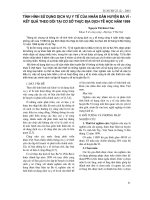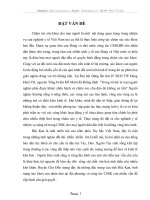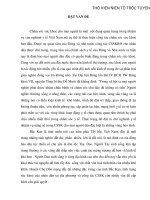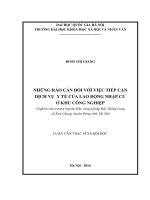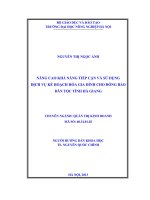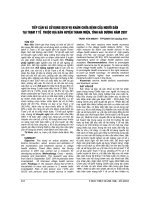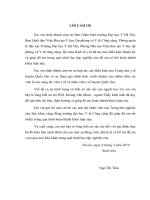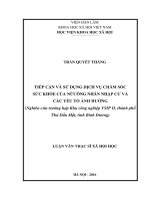Tiếp cận và sử dụng dịch vụ y tế của nhóm người nhập cư từ nông thôn vào thành phố (qua khảo sát tại thành phố hà nội) tt tiếng anh
Bạn đang xem bản rút gọn của tài liệu. Xem và tải ngay bản đầy đủ của tài liệu tại đây (596.88 KB, 28 trang )
VIETNAM ACADEMY OF SOCIAL SCIENCES
GRADUATE ACADEMY OF SOCIAL SCIENCES
*****
NGUYEN NHU TRANG
ACCESS TO AND USE OF HEALTH SERVICES BY
RURAL-URBAN MIGRANTS
(SURVEYED IN HANOI)
THESIS SUMMARIZATION
Major: Sociology
Code: 9 31 03 01
Hanoi, 2019
1
The research work was completed in the Graduate Academy of Social
Sciences.
Scientific supervisor: Professor-Doctor To Duy Hop
Comment 1: Assoc. Prof. Nguyen Thi To Quyen
Comment 2: Assoc. Prof. Mai Van Hai
Comment 3: Assoc. Prof. Duong Chi Dung
The thesis will be defended against the Academy-level Thesis Panel at
the Graduate Academy of Social Sciences
At …..(time),…..(date)…..(month)……(year)
The thesis is available at the National Library
LIST OF STUDENT’S PUBLISHED THESIS-RELATED
ARTICLES
1. Nguyen Nhu Trang & Nguyen Thi Minh Phuong, 2015:
“Rural Highlands - A qualitative analysis on social transition
(case-studied in IaNhin and IaKa communes, ChuPah district,
Gia Lai province)”. Social Science Information Review, No.
2/2015
2. Nguyen Nhu Trang & Le Thuy Nga, 2015: "Social security
in the health sector for unofficial migrant workers Suggestions on the role of social workers." Summary record of
the international scientific conference on "Challenges on
professionalism applicable to Vietnam’s social works in the
demand of integration and development". Labor Publishing
House, 2015
3. Nguyen Nhu Trang, Do Thi Le Hang & Nguyen Thi Minh
Phuong, 2018: "Developing high-quality human resources
serving sustainable development of the Southwest region".
Asia-Pacific Economic Review, No. 519, June 2018
4. Nguyen Nhu Trang, 2018: “Access to and use of health
services and health insurance by migrants in Hanoi”.
Sociology Journal, No. 2/2018.
INTRODUCTION
1. The urgency of the topic
As health is one of the fundamental factors affecting the development of
each individual and the whole society, it is the goal of countries during its course of
development to ensure that their whole citizenry get access to basic health services.
According to the 1978 Alma-Ata Declaration, access to basic health services is the
right to take care of personal health and maintain good physical and mental
conditions.
It is witnessed that the mechanical population in such urban cities of
Vietnam as Hanoi and Ho Chi Minh City has increased rapidly in recent years
because of the flow of migrants from provinces and rural areas who seek
employment or residence opportunities in big cities. It is estimated that the ruralurban migration will reach 5 million people by 2019, 1.4 million more than the
urban-to-rural migration (General Statistics Office of Vietnam, 2010). Those who
migrate from rural to urban areas in search of jobs may face potential risks in their
destinations, including health problems and access to healthcare services.
However, this issue has not yet received sufficient attention from employees
and authorities. Up to date, most of the major studies on migration often review
migrants' health and access to health services in a series of common issues,
including livelihoods, income, employment, education or difficulties that migrants
may encounter while living in urban areas (according to Le Bach Duong and
Nguyen Thanh Liem, 2011, Department of Employment - Ministry of Labor,
Invalids and Social Affairs, 2013). In fact, many rural-urban migrants have met
health challenges and diseases after living and working in the cities. When returning
to the countryside, migrants will be not only a burden to their families and localities,
but also negatively affect the productivity and labor quality of the entire economy
and society once they are not taken care of. This is obviously a huge social problem,
with multi-dimensional and multi-level effects to individuals and the society. In
order to properly understand the nature and extent of this problem, more focused
research is needed to review the issue in a more comprehensive way in terms of both
scientific and practical aspects.
Because of the above-mentioned reasons, I select the topic of “Access to and
use of health services by rural-urban migrants (surveyed in Hanoi)” as the topic of
my PhD thesis.
2. Purposes, questions and theories of the research
2.1 Purposes of the research
To clarify the situation of access to and use of health services of ruralurban migrants.
To analyze the factors affecting the access to and use of health services
of rural-urban migrants.
To suggest a number of recommendations on ensuring social security
for migrants in accessing and using health services.
2.2 Research questions
How do rural-urban migrants access and use health services for
medical examination and treatment?
Which factors affect the access to and use of medical services in
medical examination and treatment by rural-urban migrants?
2.3 Research theories
Migrants from rural areas to Hanoi have greater opportunities to access
health services and medical examination and treatment services as the
availability of health services in the city is higher than that in rural areas.
However, they are struggled accessing and using health services in the
city due to their limited ability to pay for medical examination and treatment
services, health insurance at inappropriate levels, and living characteristics of
migrants.
Institutional factors, health insurance policies and the habit of selftreatment affect the access to and use of health services of rural-urban migrants.
3. Subjects and scope of the research
3.1. Subjects of the research
Rural-urban migrants’ access to and use of health services.
3.2. Scope of the research
Scope of space: the research was conducted in Hanoi
Time range: the survey was conducted in 2016
Scope of content: the thesis focuses on clarifying the actual situation and the
factors affecting the access to and use of health services of migrants in
comparison with local residents.
4. Methodology and research methods of the thesis
4.1. Methodology
This thesis applies sociological theories such as the rational choice theory
and the capital and social network theory to explain the situation of access to and use
of health services of migrants from rural areas into the city, and explain their
decisions in selecting different medical facilities in medical examination and
treatment. The research is based on migrant workers’ rights to health care and access
to high-quality medical services for illness prevention or treatment.
To concurrently resolve the methodologies of individualistic approach and/or
collectivistic approach by criticizing the limitations of extreme views such as
individualism or collectivism only; recognizing the relative rationality of
counterbalance viewpoints such as the viewpoint that thinks high of individualism
than collectivism and vice versa; aiming to select a reconciliation viewpoint or
combine two methodological approaches: Individualistic and Collectivistic
methodologies.
4.2. Research methods of the thesis
This is a cross-sectional study, of which its research objects only provide onetime information with required contents at a certain time. The research combines 4
main methods to answer research questions, including secondary document analysis,
observation, qualitative research and quantitative research.
4.2.1. Secondary document analysis method.
4.2.2. Observation method.
4.2.3. Qualitative research method.
In-depth interview and group discussion were maintained continuously
during the fieldwork and before, during and after the quantitative survey. The indepth interview has taken into account the group of local residents, who were born
in Hanoi and are permanent residents, as the control group.
4.2.4. Quantitative research method.
The student uses the World Bank’s data set on "The situation of residence in
Vietnam". During the analysis process, the student uses the information of 648 cases
of migrants who moved to Hanoi 5 years prior to the time of the survey. The
analysis has made comparison on the access to and use of health services between
migrants and local residents who have registered permanent residence in Hanoi.
5. New scientific contributions of the thesis
The research on “Access to and use of health services by rural-urban
migrants” contributes to the general theoretical knowledge of the sociology major in
the study of access to social services for particular population groups. Urban
migrants’ access to healthcare services in cities helps ensuring health security in
their new places of residence and stabilizing their lives to make plans for the new
life. The research shows the ability to apply modern sociological theories about
rational choice, social capital and social networks. Besides, the thesis also confirms
that the topic has researched not only from a public medical or health perspective
but also from a sociological perspective in terms of health, which comes out with the
finding and explanation of social factors affecting human health in the process of
integrating into new lives. On the other hand, the research shows that the
combination of qualitative and quantitative research methods is appropriate and
support each other in explaining the raised issues. The qualitative research method is
conducted both before and after the quantitative research method to better
understand the causes and effects and explain the problems by quantitative research
results.
6. Theoretical and practical significance of the thesis.
6.1. Theoretical significance.
The thesis contributes to the enriching of definition system in
researching the access to and use of health services.
The application of theory in the research helps explaining and verifying
the appropriateness and correctness of the rational choice theory and capital
theory, and the social network in the practice of Vietnam (Hanoi case study).
To provide new theoretical knowledge for specialized research areas,
and access to Health Sociology, Urban Sociology, Rural Sociology and Policy
Sociology researches.
6.2. Practical significance.
The study on “Access to and use of health services by rural-urban migrants”
helps identifying factors affecting the process of accessing and using health services
at new residence places for those migrating to urban areas by analyzing their
practical access to and use of health services. The study also contributes practical
evidence on limited factors which are the bottlenecks causing difficulties in
accessing health services. On the other hand, the study provides evidence on the
appropriateness of healthcare policies, specifically health insurance for urban
migrants. Information obtained from in-depth interviews and group discussion shall
act as a profound database for reference of relevant studies.
The research results of the thesis may lay the foundation for making
recommendations to adjust policies in a timely manner to meet the needs in
accessing and using health services to take care of urban migrants.
7. The thesis’s structure
Apart from the introduction, conclusion, recommendations, the list of references,
lists of abbreviations, tables, figures and appendices, the thesis is divided into 5
chapters.
Chapter 1. An overview of research situation on issues related to the thesis topic
Chapter 2. Theoretical foundations of topic research
Chapter 3. Socio-demographic characteristics and health situation of rural-urban
migrants
Chapter 4. The practical situation on access to and use of health services by ruralurban migrants
Chapter 5. Factors affecting the access to and use of health services by rural-urban
migrants
CHAPTER 1
AN OVERVIEW OF RESEARCH SITUATION ON ISSUES RELATED
TO THESIS TOPIC
1.1.
The situation of rural-urban migrants
The migration trend between regions has witnessed dramatic changes in
recent years, with the rural-urban migration phenomenon replacing rural-rural
migration. The increase of population in Hanoi due to migration accounted for 30-39
percent ( In particular, the number of migrants to
the inner city accounts for about 70-80 percent of the total migrants in the city. The
main cause of migration for economic purposes accounts for 63 percent while the
irregular and seasonal rates of migration are 42 and 90 percent, respectively.
Migrant workers in urban areas mainly work in the private, unofficial, low-income
and unstable sector. Currently, the number of migrant women has increasingly
developed and occupied a large proportion amongst rural-urban migrants.
1.2. Life of migrants in the city
Most of migrants work in the unofficial sector with high working time,
unsecured labor safety conditions, low income and instability and are forced to
rent houses in the context of high urban living costs. Therefore, many have
chosen minimum spending solution, including medical expenses. This has
increased the risk of illness accumulation that they may suffer in the future.
1.3. Access to and use of social security services by migrants
Situation of access to social security services by rural-urban migrants
One may assume that migrants who are poor must have encountered
certain barriers to access social security services. According to the latest study
conducted by Action Aid, 63.3 percent of unofficial migrant workers in Hai
Phong City have no access to social security service, while that number in Ho
Chi Minh City is 90 percent (Action Aid, 2014).
“The proportion of migrant workers participating in different types of
voluntary insurance remains low due to the following main reasons: 1/Freelance migrant workers has unstable income while the voluntary insurance
premiums are extremely high; 2/- Migrant workers do not have access to
information on insurance types, therefore are not aware of the benefits of these
insurances; 3/- Supportive policies from local authorities to promote migrant
workers’ participation in insurance are insufficient” (Pham Van Quyet, 2014).
Access to and use of health services by rural-urban migrants
Different migrant groups have different levels of access to health
services. This depends on their residence registration, social positions and
economic conditions as well as the awareness on healthcare of the migrants
themselves. In addition, the State's policies towards migrants and permanent
residents are different while there also remains discrimination between the
insured and non-insured in the healthcare system (Le Bach Duong and Nguyen
Thanh Liem, 2011). Access to healthcare services is mainly taken by family
themselves or by selecting medical establishments suitable to their pockets.
There remain several shortcomings in the migrants’ receiving of healthcare
services at their destinations (Nguyen Huu Minh et al., 2005).
The research results also reveal that there are differences in health care
between different groups of migrants and between different regions. Female
migrant workers tend to choose state facilities for medical examination and
treatment rather than male laborers. Migrants to Hanoi use health insurance
cards more than those who migrate to other regions (General Statistics Office of
Vietnam, 2006: 97). Before migration, the proportion of migrants using
contraception is similar to that of non-migrants. This rate increased significantly
after they moved to new places (Institute of Sociology, 1998). Migrants' health
insurance accessibility varies between residence groups. The rate of nonregistered migrants having health insurance cards is remarkably low (Dang
Nguyen Anh et al., 2007).
1.4. A number of comments and direction of the topic
Studies have shown policy gaps in the migrants’ ability to access and use
basic social services in urban areas. Healthcare service is one of the five
fundamental social services that the Government is paying attention to, especially
for urban migrants. Besides, one should take into account whether migrants should
have health insurance cards or not, and whether different migrants in different
regions should use their cards for medical examination and treatment. In addition,
migrants working in offical sectors tend to have better access to health insurance
than those in unofficial sectors.
The research will continue analyzing the process of access to and use of
health services, factors related to the migrants’ access to and use of health services in
the cities in the context where related policies and regulations of the government
have changed in favor of urban migrants. The research also studies the interactions
between individuals and groups of migrants in the decision-making process of
choosing and using health services. We not only focus on the in-depth analysis of
access to and use of health services from the perspective of health insurance
coverage, but also present in-depth analysis on the issue of health insurance at
inappropriate levels, household health insurance, and health insurance payment
when migrants approach health services for medical examination and treatment. The
research approach is taken not only from the perspective of policy analysis or
service delivery system but also from service users on the basis of applying the
rational choice theory and social capital and social network theory to consider the
factors related to their decisions on accessing and using health services.
CHAPTER 2
THEORETICAL FOUNDATIONS OF TOPIC RESEARCH
2.1. Tool definitions
2.1.1. The definition of access in health sector
The study of the thesis reviews migrants’ access to health services based
on their ability to reach health facilities upon necessity. This means that when
there is a need for medical examination and treatment, which maybe a periodic
health check, illness or injuries that need to be examined and treated, the
migrant may enjoy health services in health facilities.
2.1.2. The definition of health service use
Using health services is the process of interaction between patients and
health services in healthcare activities, and is the process of implementing steps
or methods to achieve health in the best way. The use of medical services
benefits users’ health and users have the right to choose how to use the service
or claim the quality of the service.
2.1.3. The definition of health services
According to the World Health Organization (WHO), "health services
include all services of diagnosis, treatment of diseases and healthcare and
rehabilitation activities. They include personal and community health services.”
Health services include outpatient and inpatient medical examination and
treatment, meeting the demand on healthcare of the people. Health services are
also construed as health programs that take care of and improve people's health.
All health services are provided in healthcare facilities, which are
construed as places of medical examination and treatment and healthcare,
including hospitals from central to local levels (central hospitals, provinciallevel hospitals and district-level hospitals), private hospitals, international
hospitals, specialized hospitals, sectoral hospitals, regional clinics and
commune/ward health stations.
2.1.4. The definition of health insurance
According to the Vietnamese Law on Health Insurance, “health insurance is
a form of insurance applied to the healthcare sector for not-for-profit purposes, the
implementation of which is organized by the State.”
This study reviews the migrants’ access to and use of health services,
which are not only based on their residence status but also on whether they are
covered by health insurance or not. The study will analyze the differences in
accessing and using health insurance among the insured and non-insured
participants.
2.1.5. The definition of rural-urban migrants
In order to clarify the definition of rural-urban migrants, it is necessary to
first define the definition of migrants. Migrants are those who move from one
territory to another to establish a new place of residence within a certain period
of time. This definition is used by the United Nations to affirm the connection
between a certain distance movement through an administrative boundary, and a
change of residence (Dang Nguyen Anh, 2009).
Within the scope of the thesis topic, rural-urban migrants are defined as
those who move from rural areas to cities. The thesis focuses on studying
migrants from rural areas to Hanoi.
2.2. Research theories
2.2.1. Rational choice theory
The theory of rational choice is based on the premise that a person always
act deliberately, thinking to select and use resources reasonably in order to
achieve maximum results with minimum costs. That is, before deciding an
action, a person always measure its costs and benefit, only taking action if the
cost is equal or smaller than the benefit and not doing so if the cost is higher
than the benefit such act may bring.
The theory of rational choice is represented by George Homans and Peter
Blau. The rational rational choice theory helps us to explain migrants’ decisions
in the selection of medical services (medical examination, consultation and
treatment, etc.). These choices, apart from such factors as occupation, education
level, economic ability, among others, must be made based on their social
capital as well as their network of relationships (family and society). Therefore,
we will introduce different perspectives of scholars on social capital as well as
the social network theory in the next section.
2.2.2 The definition of social capital and the social network theory
The definition of social capital
Although there are different interpretations and definitions, these
definitions and explanations have one thing in common: the social capital
supports the ability of the acting subject to seek benefits when they have
membership in social networks. It can be seen that social capital has the
following fundamental characteristics: 1)- trust and confidentiality; 2)reciprocity and mutual benefits; 3)- rules, standards and sanctions; 4)- the ability
of combination into a social network.
Represented by Pierre Bourdieu, James Coleman and Robert Putnam, the
theory highlights the dimensions: faith (confiance), network (réseau) and
reciprocity (réciprocité). The social network theory also helps us to clarify
social space, links and capital.
Social network is a collection of links between individuals or population
groups. The characteristics and nature of the social network structure are studied
from different directions, which is the structure of social relations, social
interaction and social relations among individuals and between individuals and
collectives. On the sociological level, the concept of social networks is based on
social interaction system theory (Vu Quang Ha, 2001).
CHAPTER 3
SOCIO-DEMOGRAPHIC CHARACTERISTICS AND HEALTH
SITUATION OF RURAL-URBAN MIGRANTS
3.1. Socio-demographic characteristics of migrants to Hanoi
3.1.1. Gender
The proportion of men and women in the survey sample is different, with the
percentage of women is about 5 percent higher than men: 47.8 percent of
respondents are male and 52.2 percent of respondents are female.
3.1.2. Age groups
The majority of migrants to Hanoi are in the working age (76.8 percent). The
under-18-year-old group accounts for 22.2 percent, mostly are children
accompanying their families or living with their parents in migrant families or are
the babies who were born during the time their parents live in urban areas. The
group of over-60-year-old migrants makes up only 1 percent. These are the people
who are working or are grandparents looking after their grandchildren. With a small
percentage of only 1 percent of the total number of migrants, there will not be much
value to analyze the process of accessing and using urban health services by this
group. Therefore, the analysis focuses on the group of people in the working age
(76.8 percent).
3.1.3. Educational level
Migrants graduated from high schools accounted for the highest proportion of
47.3 percent. The group holding higher education degrees ranks second with 11.6
percent and is equivalent to the group without degrees (11.2 percent). The group of
which migrants are graduated from colleges and secondary schools are nearly the
same: 9.7 percent and 10.3 percent. The remaining groups, including primary and
intermediate vocational schools and professional high school; primary schools; and
postgraduate level, account for 6.7 percent, 2.7 percent and 0.5 percent, respectively.
3.1.4. Marriage status
The number of single migrants accounts for 65 percent of the total number of
migrants, doubling the rate of married migrants (33.7 percent). Legally
separated/divorced and widowed migrants account for a very small percentage, only
0.4 percent and 0.8 percent, respectively.
3.1.5. Ethnic composition
Kinh people account for the majority of 95 percent, while other ethnic groups
such as Thai, Tay or Hoa only make up a total of 4.5 percent. Migrants from rural
areas to Hanoi are mainly from lowland provinces, only a few are coming from
mountainous provinces. Migrants from ethnic minorities often face the barrier of
language, education, skills, geographical distance and other soft skills. It may be the
cause of limiting the migration process of ethnic minorities to the city.
3.1.6. Employment and occupational status
Migrants work in different occupational groups, with the highest rate being
those working in the service/sales group (29.5 percent). These jobs are personal
service staff, sales staff, personal care workers and securities. The simple labor
group ranks second with 21.5 percent, while middle-level and handicrafted workers
are nearly equal with 14.3 percent and 13 percent. The group of machinery
assemblers and operators ranks fifth with 11 percent. The rest are office staff (6.5
percent) and the group working in the high-level professional sector (4.2 percent).
The average income of migrants at the time of the 2015 survey was VND 3,753,000
per month (2015/2016 HRS data analysis).
3.1.7. Time of migration to Hanoi
This study only analyzes those who migrated to Hanoi 5 years before the time
of the survey, which is from 2010. During 2010-2015 alone, the total number of
migrants to Hanoi accounted for 56,2 percent of the total number of migrants to the
city in the survey sample.
3.1.8. Household characteristics
Household size of migrants to Hanoi is smaller than that of permanent
residents. The household size of immigrants is 2.7, much lower than the household
size of permanent residents of 4.1. 18 percent of migration households have 1 single
person, while only 3 percent of households of permanent residents have one person.
While the percentage of households with children in permanently resided families is
60 percent, this rate in migrant families is only 33 percent. The average age of
migrant household owners is 34 years old, much younger than the average age of
permanently residing families, which is 47. The marriage rate of owners of
permanently resided families is 91 percent while that of migrant households is 75
percent.
CHAPTER 4
THE PRACTICAL SITUATION ON ACCESS TO AND USE OF
HEALTH SERVICES BY RURAL-URBAN MIGRANTS
4.1 Access to health services by rural-urban migrants
4.1.1 Availability and accessibility of medical services
Healthcare service is one of the 5 basic social services necessary for the
life process of human. Hanoi is the city with diversed and high-quality medical
service system, including medical stations in wards/communes, district-level
medical centers, general clinics, general hospitals at district-, provincial- and
central-level, specialized hospitals, sectoral hospitals, international hospitals,
and private hospitals, among others. There is also a system of high-quality
private clinics to serve the healthcare demand of the people. Healthcare
facilities are always available to serve medical examination and treatment
demand the whole citizens in general and urban immigrants in particular.
Health facilities in Hanoi are usually located in positions whereas
convenient for everyone to reach and access easily for medical examination
and treatment. The distance from households to health facilities in Hanoi is
relatively convenient with the system of health facilities covered in almost
every urban and suburban district. The availability of medicines and medical
human resources are the factors that create the convenience and readiness for
access to health services by the citizens in general and urban migrants in Hanoi
in particular.
4.1.2 Access to health services with health insurance
Health insurance coverage rate
The rate of citizens covered by health insurance, especially health
insurance at their places of residence, is one of the criteria to assess the access
to and use of health services of rural-urban migrants. The current health
insurance coverage rate for rural migrants to Hanoi is 77 percent while this rate
is 76.1 percent for local residents (2015/2016 HRS data analysis), higher than
the health insurance coverage rate of migrants nationwide. Thus, it can be seen
that the rate of migrants covered by health insurance in Hanoi is relatively
high, ensuring their access to health services and medical examination and
treatment with health insurance.
Access to health services with health insurance at inappropriate levels
However, among migrants who are covered by health insurance, the number
of health insurance of inappropriate levels is quite high, accounting for 28 percent,
mainly concentrated in the group of over-40-year-old persons who are main
laborers. This is also the group whose health conditions show signs of decreasing
due to ageing problem. Thus, migrants covered by health insurance registering for
medical examination and treatment in other provinces/cities but have not yet
transfered health insurance to their new places of residence will face several
difficulties for enjoying health insurance regimes.
Access to health services according to registered places for medical
examination and treatment under health insurance cards
The analysis results also show that access to health services by migrants is
significantly related to their registered places for medical examination and
treatment under health insurance. In both migrant and local groups where the
health insurance is registered in residing districts, the rate of citizens choosing
district-level hospitals is relatively high (23.8 percent and 24.1 percent,
respectively) while the rate of migrant and local patients visiting hospitals in the
city is lower (15.9 percent and 17.2 percent, respectively). However, the proportion
of people who come to central hospitals of the group where medical examination
and treatment is registered in districts/rural districts is currently lower and at the
lowest level compared to the groups registering medical services in other districts
and provinces. The highest proportion of people who come to central hospitals lays
in the migrant group who register for health insurance treatment in other
provinces/cities (42.5 percent). Those who are not covered by health insurance also
topped at choosing medical examination and treatment at central hospitals (39.1
percent for migrants and 42 percent for local residents). This has further affirmed
the quality of health services at central-level hospitals, which are highly
appreciated and selected by a majority of citizens. It is noteworthy that the rate of
using health insurance for outpatient medical examination and treatment by the
migrant group having registered for medical examination and treatment in Hanoi is
38.4 percent, while this rate in the group having registered for health insurance
treatment in other provinces and cities is only 20 percent. Thus, the fact that
migrants having successfully registered healthcare facilities in Hanoi has helped
improving their rate of using health insurance for inpatient medical examination
and treatment, of which the costs will be high for not using health insurance.
However, the proportion of migrants using health insurance for inpatient medical
examination and treatment in the group registered for medical examination and
treatment covered by health insurance in Hanoi is lower than that of those who
have registered for health insurance-covered medical examination and treatment in
other provinces and cities (15.2 percent compared with 27.5 percent). The reason is
that the use of health insurance for outpatient medical care in Hanoi is not really
convenient and effective compared with the use of health insurance in their
provinces or cities of residence or compared with not using health insurance.
4.1.3 Access to health services by migration time
There are two factors that one cannot skip when conducting research
on emigrants and migrants, which are space and time. Space is the places
wherever the migrants go and stay. In this study, their living space is in
Hanoi. The time is understood to be the period of time they have lived in
the migration areas since they arrived and began to live continuously.
The analysis focuses on 3 groups: the group of newly migrated ones
within 5 recent years, the group of migrants who have moved to Hanoi for
more than 5 years and the group of local residents. The research analyzes
the accessibility of health services of those who are sick (who need
medical treatment). The highest rate of accessing health services belongs to
the migrant group of less than 5 years (65 percent) while the lowest is the
over-5-year migrant group (60.3 percent), and the rate of access to health
services in the local group is 63 percent. It is drawn that about two-thirds
of the people in the three groups have accessed health services when being
sick, and there are insignificant disparities between groups, fluctuating
within 5 percent.
4.2. Use of health services by rural-urban migrants
Using health services is the process of interaction between human being
and health services in healthcare activities, and is the process of implementing
steps or methods to achieve health in the best way. The use of medical services
benefits users’ health and users have the right to choose how to use the service
or claim the quality of the service. Within the scope of the thesis, the author will
describe and analyze the main contents of using health services, including selection
of treatment methods and selection of places for medical examination and treatment.
Besides, the thesis will analyze the use of health services according to the migration
time of the group compared with the local residents.
4.2.1. Selection of treatment methods
In the last sickness, 62.4 percent of migrants in Hanoi went to health
facilities to use healthcare services. About one-third of the surveyed people go
with self-treatment by buying medicines in pharmacies according to the seller's
instructions, or by purchasing the medicines that were previously taken if they
felt like having the same symptoms. Explaining their decisions to buy
medicine at pharmacies without going to health facilities or seeing doctors for
treatment, migrants all said that it is convenient, fast, inexpensive and they
have recovered by doing so before. Migrants tend to take it simple to treat
common diseases that way. Long working time, instability and difficult life
give these workers less attention to healthcare. Low income and the pressure to
make money and send money to their hometowns have contributed
significantly to this non-encouraged behavior. The lack of benefits of the
public health system because they are "off-line" may also be one of the causes
of self-treatment behavior leading to inefficiency and other health risks.
However, migrants may only do so when they face common health problems
such as flu, abdominal pain, headache and body aches. When having bigger
problems such as severe illness that require treatment, scans, screening or
testing or diseases that require medical intervention, immigrants have to select
other options. Compared to local residents who have permanent residence in
Hanoi, the proportion of migrants using health services when being sick or
having health problems is not too different.
4.2.2. Selection of medical examination and treatment establishments
The analysis shows that 36 percent of migrants in Hanoi choose health
services at their places of residence, mainly in the wards and districts where
they reside. Meanwhile, 64 percent of migrants had to go to another place to
seek medical care, possibly another district or province/city. Regarding the
group of local residents, the proportion of people using health services for
medical examination and treatment at their places of residence is 44.8 percent,
while the people using health services for non-resident healthcare accounts for
55.2 percent, mainly health services in other districts in the city. Only a few of
local residents in the research sample take medical examination and treatment
in other provinces or cities, mainly due to their works (their agencies are
located in neighboring provinces and they only return to Hanoi on weekends).
Medical examination and treatment at the places of residence is convenient in
terms of movement, travelling time and costs. Meanwhile, migrants are
actually having more difficulties than local people in using health services that
are not in the same place of residence. The number of migrants using health
services mainly for medical examination accounts for 64.7 percent, while that
for treatment makes up 75 percent. In addition, the use of health services for
reproductive healthcare - family planning and vaccination account for small
proportions of 8.1 percent and 3.7 percent, respectively.
4.2.3. Use of health services under migration time
Which medical facilities did rural-urban migrants select to use health
services for their examination and treatment? Most of them chose central-level
hospitals with an equally high rate in all 3 migrant groups of less than 5 years,
over 5 years and local residents: 38.8 percent; 37.8 percent and 40.1 percent.
Obviously, there is no big difference in the use of health services by these 3
population groups. The selection of health services at facilities in examination
and treatment of diseases among groups are almost the same. We continue to
analyze in depth the situation on use of health services by these groups based
on their status of being covered and not being covered by health insurance,
showing that all three groups, including the insured and non-insured, tend to
use health services at central-level hospital. Among the non-insured migrants,
the group of migrants who have migrated to Hanoi for less than 5 years has the
lowest rate of using health services at provincial/city hospitals, only 8.3
percent, much lower than the group of migrants who have moved to Hanoi for
more than 5 years (30.3 percent) and the local group (19.6 percent). Compared
with the insured ones who use health services at provincial/city hospitals, this
rate is much higher in the three above-mentioned groups, with 17.1 percent,
33.1 percent and 20.4 percent, respectively. It can be seen that health insurance
is likely to be more influential to the use of health services compared to the
time the migrants reside in Hanoi.
4.2.4. Rational selection of health services
Within the scope of the thesis, we analyze the behavior of rational selection
of the process of accessing-using health services in the health care of migrants in
the perspective that selects appropriate health services so that the costs of medical
examination and treatment is low but ensures the highest medical examination and
treatment efficiency together with the most convenient care for patients. The
rational selection on healthcare service of a person is considered based on many
factors, for example, his/her habits, interests, customs, experience, personal
relationships, culture, social standards, or prestige of medical facilities,
professional qualifications of doctors, health insurance status, among others.
Therefore, the way of choosing healthcare services of each person is different that
they consider to be the most reasonable for themselves. Obviously, to make the
most rational and beneficial healthcare decision, one must consider several factors,
including internal and external ones. Therefore, choosing a treatment method,
medical service or medical facility to some extent may be the most rational choice
for a person but not for an other. That is the reasonableness/unreasonableness of
limited rational choice!
4.3. Access to and use of health services on reproductive healthcare and
prevention of HIV transmission for rural-urban migrants
Young immigrants is the group with active reproductive activities, so the
risks associated with reproductive health and sexual health are also higher than
other groups of age. According to the General Statistics Office, 46.9 percent of
non-migrants believe that migrants are more likely to be infected with HIV
than non-migrants. Although being classified as a population group with high
risks of reproductive diseases, none of the surveyed female and male migrant
workers have completed periodic checkup. It is alledged that they feel "shy"
when being examined for reproductive health issues. Most people who move
to Hanoi have access to and access well to knowledge and ways to prevent
sexually transmitted diseases from television or the mass media. However,
they have limitations in access to intervention programs on reproductive health
care and HIV prevention in their residing areas because the time that these
programs are broadcasted are often in working hours. Meanwhile, the migrant
group has few activities at their residing place as they work all day and return
home lately and therefore cannot be advised by local authorities.
CHAPTER 5
FACTORS AFFECTING THE ACCESS TO AND USE OF HEALTH
SERVICES BY RURAL-URBAN MIGRANTS
In this Chapter, we focus on analyzing the impact of institutional, cultural and
economic factors and health insurance policies on the access to and use of health
services by rural-urban migrants. The groups of factors are as follows:
5.1. The group of institutional and policy factors include health policies
and health insurance
Up to date, the Vietnamese Government has made several positive
changes in completing regulations (institutions) and policies on health care,
ensuring equality for all people in accessing and using the health service system
when having health problems. The Health Insurance Law has been revised to
create favorable conditions for population groups to access easily to highquality public health services, while the "policy gaps" have also been gradually
narrowed as the conditions for purchase of health insurance and regulations on
use health services have been simplified. However, in fact, rural-urban migrants
still face certain limitations when accessing and using health services in the new
places of residence due to their inappropriate-level health insurance.
Despite the fact that the health insurance coverage is relatively high with 77
percent of the surveyed migrants participating in health insurance, it is more
important to help rural-urban migrants actually benefit from the services during the
process of accessing and using health services covered by health insurance, making
health insurance really a support for migrants in healthcare activities. The lack of
health insurance, use of health insurance at inappropriate levels or the habit of self-
treatment and self-purchase of medicines are all negative factors that affect the
quality in accessing and using health services by urban migrants.
5.2. The group of cultural factors
The patients’ habit of self-treatment and self-purchase of medicines without
being consulted by doctors when having health problems, along with the fear
and non-awareness of health problems, have affected positive behaviors in
terms of healthcare and access to health services. Analysis of survey data
shows that there remains a high rate of migrants who do not access health
services and only purchase medicines for self-treatment at home (52.2
percent). This cultural habit exists not only in the group of newly migrated
ones but also among those who have lived in the city for a long time. They are
seen easily putting their trust in the pharmacists instead of following doctors’
prescriptions. This habit of self-treatment not only reduces the awareness of
accessing the health system for medical care but also leads to other risks,
including inaccuracy in self-diagnosis and dose, tardiness in seeking medical
consultation upon required or having unusual and serious side effects, unsafe
drug interactions, as well as the risk of depending on and abusing drugs,
among others. Self-treatment may help us less anxiety than waiting for a
doctor's visit, but it surely is not a safe method to treat the disease.
With health being the most precious property of every person and one should
rather prevent than treating the disease, it is necessary to give periodic health
checks a priority. However, many people are assuming that doctoral visits should
only be done when their bodies show signs of fatigue. This is definitely a wrong
and extremely dangerous concept. In fact, many people only have their health
checked when having clearly seen symptoms, therefore when the disease is at last
stages, the treatment will be difficult and expensive. In all cases of in-depth
interviews, none of the asked migrants have taken periodic health examination,
only 1 of them has thought about periodic health checkups but not yet able to do
so.
There are differences in health insurance status between men and women:
Among those who are covered by health insurance, women
dominating with 80.9 percent of female migrants in Hanoi are
covered by health insurance, while this rate in male migrants is 72.4
percent.
In the group without health insurance, the proportion of women is
lower with 19.1 percent while the proportion of men is 27.6 percent.
The factor of gender not only creates a difference in access to and use of
health services and health insurance but also affects both groups’ decisions on
accessing and using services. Women are often willing to approach health facilities
for health services upon necessity while men are less willing to do so because of
their reluctance to wait for services or hesitation with administrative procedures.
5.3. The group of economic factors
Migrants in Hanoi have low and unstable income while urban medical
costs are higher than in other areas. Therefore, migrants tend to ask for the
community’s assistance when they have health problems that need to access
and use health services. The mobilization for help of migrants with the same
situation has driven the process of accessing and using health services in a
better manner, reducing medical costs for migrants. Income is the factor that
not only affects the access to and use of health services of migrants, but also
reduces positive healthcare activities such as periodical health check and
medical examination and treatment at health facilities for sicknesses and
reduces the opportunity to access high-quality medical services in urban areas.
The expenses for medical examination and treatment, if are not covered by
health insurance, will be taken from the expenditure of the migrant himself or of
his family. While the income of rural-to-urban migrants is currently low for them
to pay for daily costs, urban medical costs are considered more expensive than in
the countryside. Apart from such direct costs as consultation fee, money for
testing, medicine and other medical supplies, patients also have to pay for meals,
travel expenses and other arising expenses. Their income is also reduced due to the
days of illnesses that they are unable to work. In addition, 45.6 percent of migrants
access and use health services but are not covered by health insurance. It is clearly
